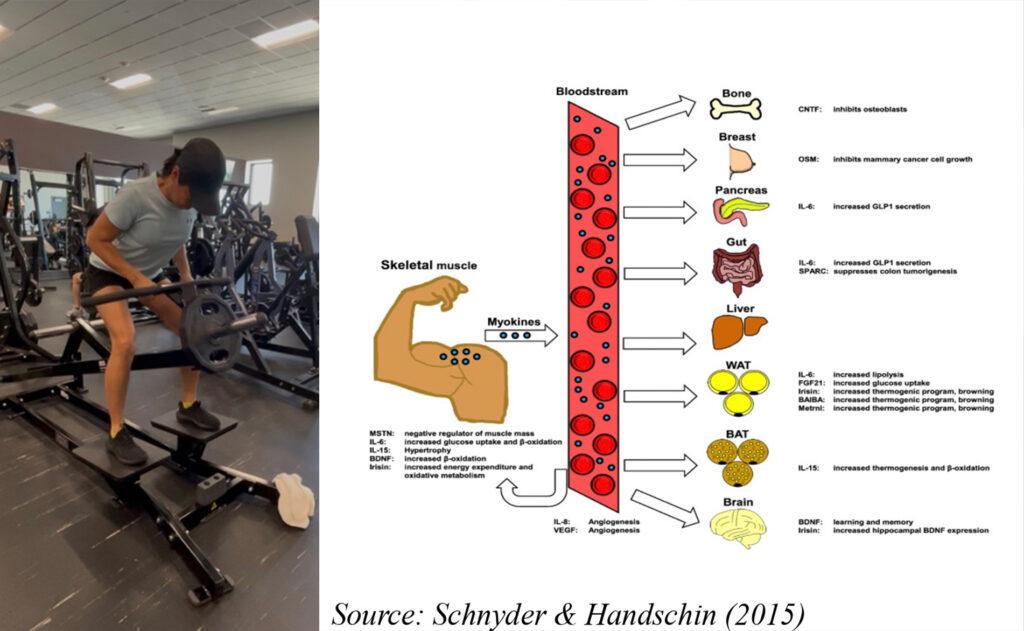It is well known that exercise is beneficial for our body and brain health. There are numerous studies and databases in PubMed, EMBASE, MEDLINE, and the Cochrane Library that suggest exercise in particularly strength training or resistance training influences muscles, nervous systems, organs, bone density, metabolism, and fitness levels (1). One may ask how exercise can do such an intricate miracle for our body and mind. It is now resolutely founded that skeletal muscle tissue produces and secretes cytokines and other proteins, which are named myokines. Current evidence suggests that exercise mediates the secretion of specific myokines to crosstalk of muscle and organs, including IL-6, IGF-1, BDNF, CTSB, Irisin, and LIF, which establish self-regulatory circuits between the brain and muscle function (2). More study needs to explore the effects of different exercise modes at multiple time points on myokine response (3).
For those who would like to integrate strength training into their exercise regimen, I will give you some science-based essential strength training tips. When one performs a bout of strength training, evidently, one will increase total body strength, reduce body weight and body fat, and overall health (4). This is because strength gains occur by increasing muscle, bone, tendon, joint, and ligament strength. Strength training is an anaerobic exercise that can include bodybuilding, weightlifting, and powerlifting. Anaerobic means exercise performed without oxygen, which involves short and intense bursts of exercise. The goal of strength activities is to produce a large amount of energy in a short period. Oftentimes, so fast that it skips over trying to use oxygen for fuel.
Strength training involves trying to induce muscular contractions using resistance or force. There are four essential strength training movement patterns that one can do. They are the squat pattern, hinge pattern, push pattern, and pull pattern. Squat is one of the most popular exercise movements. Squatting with TRX suspension training straps with their bodyweight is my recommendation for senior people. Notably, most of the strength training movements involve more than one muscle group. And it is called compound exercise. Compound exercises are more time-efficient as they target multiple large muscle groups at once. Compound exercises help improve functional fitness and prevent injuries by using the whole body. On the contrary, isolation exercises target one specific muscle or body part. In conclusion, compound movements help you avoid wasting time on isolation exercises. A word of caution to novice strength exercisers is to learn the correct techniques from an internationally certified fitness professional and warm up your body adequately when you work out.
About the Author
Dr. Jesslyn Oi is an advocate of Fitness and Health. She has been doing strength training for 35 years. She is a Life Affiliate Member of the Association of Integrative Medicine Malaysia, a member of the Institute of Corporate Directors Malaysia, and co-founder of the International Sports Science Association Malaysia.
References
1. Vints, W. A. J., Šeikinaitė, J., Gökçe, E., Kušleikienė, S., Šarkinaite, M., Valatkeviciene, K., Česnaitienė, V. J., Verbunt, J., Levin, O., & Masiulis, N. (2024). Resistance exercise effects on hippocampus subfield volumes and biomarkers of neuroplasticity and neuroinflammation in older adults with low and high risk of mild cognitive impairment: a randomized controlled trial. GeroScience, 46(4), 3971–3991. https://doi.org/10.1007/s11357-024-01110-6
2. Gao, X., Chen, Y., & Cheng, P. (2024). Unlocking the potential of exercise: harnessing myokines to delay musculoskeletal aging and improve cognitive health. Frontiers in physiology, 15, 1338875. https://doi.org/10.3389/fphys.2024.1338875
3. Bettariga, F., Taaffe, D. R., Galvão, D. A., Lopez, P., Bishop, C., Markarian, A. M., Natalucci, V., Kim, J. S., & Newton, R. U. (2024). Exercise training mode effects on myokine expression in healthy adults: A systematic review with metaanalysis. Journal of sport and health science, 13(6), 764–779. https://doi.org/10.1016/j.jshs.2024.04.005
4. Ohlsson, C., Gidestrand, E., Bellman, J., Larsson, C., Palsdottir, V., Hägg, D., Jansson, P. A., & Jansson, J. O. (2020). Increased weight loading reduces body weight and body fat in obese subjects – A proof of concept randomized clinical trial. EClinicalMedicine, 22, 100338.
https://doi.org/10.1016/j.eclinm.2020.100338

